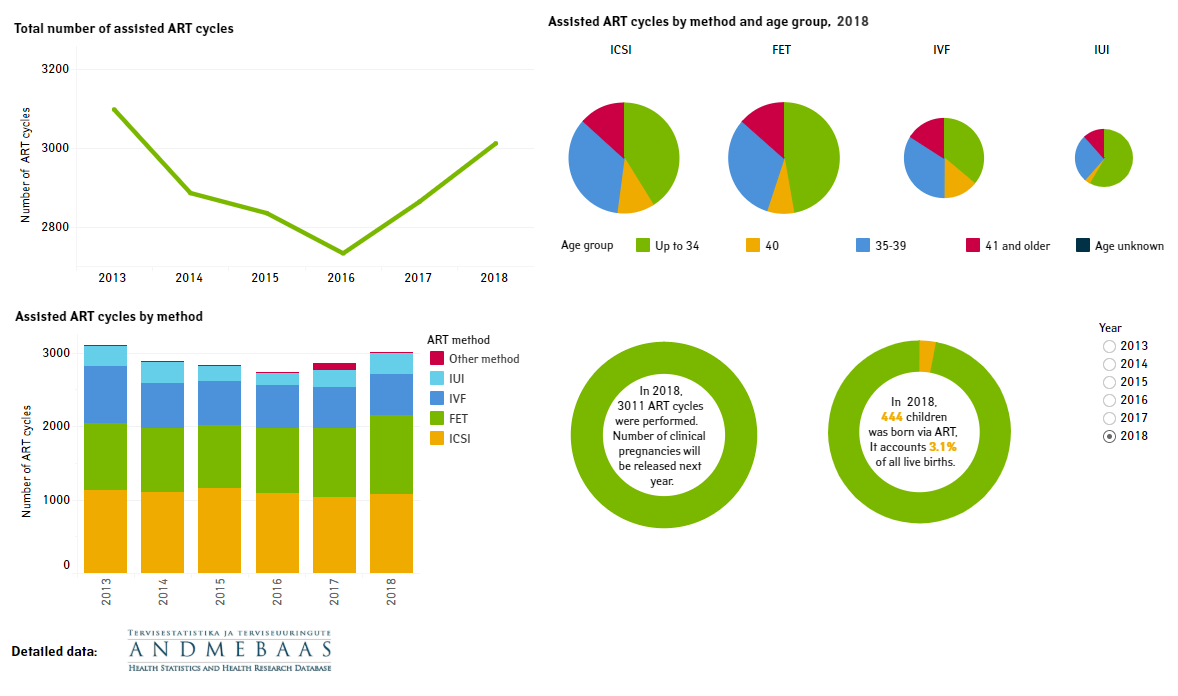In 2018, the use of infertility treatment in Estonia increased
17 JULY 2019
Estonian State Agency of Medicines data shows 3011 assisted reproductive technology (ART) cycle procedures in 2018, having increased by 5% compared to 2017. In 2014–2016, the number of ART cycles decreased, while since 2017, the ART cycles are again increasing.
In 2018, most frequently used ART method was frozen embryo transfer (FET) and intracytoplasmic sperm injection (ICSI) – both 36% of all ART cycles. ICSI method is used in case of sever male infertility. Intrauterine insemination (IUI) was the method least used, representing only 10 % of all ART cycles.
Compared to the year 2017, the use of IUI method (25%) increased the most. This is the procedure where sperm is placed directly in the woman’s womb with a special catheter. IUI is performed for male infertility problems or female infertility due to cervical issues. The costs of this method are not covered by state.
In 2018, FET and ICSI are the most frequently used methods in all age groups. Infertility treatment increased most among 40-year-old women (27%) and treatments decreased among 41 and older women. Infertility treatment is most commonly used among two younger age groups – 34-year-old and younger women and 35–39-year-old women. Almost half of the ART cycles were performed for age group 34 and younger.
Until 2016, two embryos were most frequently transferred during one procedure. Since 2017, this trend changed and the most common was the single embryo transplantation. In 2018, the single embryo transplantation has increased 20% compared to the previous year. The number of transferred embryos and zygotes increased about 2% compared to 2017.
In 2018, state spending on infertility treatment services was 2.481 million euros, having increased by 4 % compared to 2017.
In 2017, artificial inseminations ended with 890 clinical pregnancy, which is 30% of performed ART cycles. In most cases, partner donation was used (83%) following the usage of donor egg (7%) and donor sperm (7%). ART side effects occurred in 10 patients.
In 2018, 444 children were born via artificial insemination in Estonia according to Estonian Medical Birth Registry. This is 14 children more than in 2017 and it accounts 3% of all live births.
Detailed data have been published in the statistical database (see tables KV10–KV14) and visualized data can be found here:
Mental and behavioural disorders, 2018
20 JUNE 2019
The number of people with mental and behavioural disorders consulted and cured by psychiatrists in 2018 has been published in the Health Statistics and Health Research Database.
In 2018, there were 2% more outpatient visits to psychiatrist among adults and 4% less outpatient visits to psychiatrist among children (up to 14 years old) than year before.
Statistical data collected from psychiatric service providers shows that in 2018 nearly 103,600 people turned to psychiatrist outpatient appointment, i.e on average every 13th person in Estonia. Over 90% of them were 15 or older.
The most frequent diagnoses were neurotic, stress-related and somatoform disorders and mood disorders in 2018, occurring respectively in 25% and 22% of cases. These disorders are more common for women, occurring two times frequently than for men. The most common diagnosis for men was mental and behavioural disorders due to psychoactive substance use, which were reported nearly four times more than for women. Of the mental and behavioural disorders due to psychoactive substance use, 74% were caused by the use of alcohol and 13% by the use of opioids.
Last year, more children were born in Estonia
12 JUNE 2019
According to the data of the Estonian Medical Pregnancy Information System of the National Institute for Health Development in 2018, a total of 14,281 children were born in Estonia, which is 606 more than year before. The number of abortion performed according to a woman's request decreased.
Data for births and abortions are published in health statistics and health research database.
Estonian health care personnel 2018
17 JUNE 2019
National Institute for Health Development has published Estonian health care personnel statistics for 2018 in Health Statistics and Health Research Database.
Data on health care personnel, Hospital Masterplan hospitals and health care providers can be found in the database part „Health care resources and their use“, by choosing the links „Health care personnel“, „Hospital Masterplan hospitals“ and „Health care providers“, respectively.
The use of health care services in European countries by Estonian insured patients has increased, but the treatment of foreigners in Estonia remain at the same level
23 MAY 2019
In 2018, health care providers from other European countries submitted invoices to the Estonian Health Insurance Fund for the health services of Estonian insured persons or Estonian pensioners and workers temporarily staying there for nearly 10 million euros, which is nearly 40% more than a year earlier. The number of Estonian patients in other European countries has been the highest in Finland, followed by Germany.
Overall, people insured in Estonia received treatment in 30 European countries. While health care services were the most widely used in Germany in 2015 and 2016, then in 2017 and 2018 the majority of medical bills came from Finland.
The data exclude data provided under scheduled treatment or directive of the European Parliament and of the Council on the application of patients’ rights in cross-border healthcare, which, in addition to the 10 million mentioned above, represent about another 10 million euros.
In turn, nearly 7,000 insured people from European countries used Estonian health care services per year, and this size has remained stable over the past four years. The people who were insured in Finland received the most treatment in Estonia – there were over 4,000 of them.
The data are published in the Health Statistics and Health Research Database of the National Institute for Health Development.
See the vizualized data here of treatment cases of insured people in Estonia from European countries.

